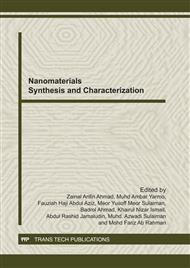p.243
p.248
p.254
p.260
p.266
p.272
p.278
p.283
p.288
Synthesis and Characterization of Silicotungstic Acid Nanoparticles via Sol Gel Technique as a Catalyst in Esterification Reaction
Abstract:
Glycerol monooleate (GMO) as an esterification product of oleic acid and glycerol is highly potential as an anti-friction substance in the engine lubricant. The purpose of this work is to study the synthesis, characterization and catalytic performance of solid heteropoly acid catalysts, namely silicotungstic acid bulk (STAB) and STA-silica sol gel (STA-SG). The activity and selectivity of STAB and STA-SG in the esterification reaction have been investigated and compared to the homogeneous catalyst i.e. sulphuric acid (H2SO4). The synthesized catalysts were characterized by BET, XRD, TEM, XPS and TPD-NH3. BET analyses shown that the STA-SG catalyst is very high in surface area compared to STAB of 460.11 m2/g and 0.98 m2/g, respectively. From the XPS analyses, there was a significant formation of W-O-Si, W-O-W and Si-O-Si bonding in STA-SG compared to that in STAB. The main species of O1s (90.74 %, 531.5 eV) followed by other O1s peak (9.26 %, 532.8 eV) were due to the presence of W-O-W and W-O-Si bonds, respectively. In addition, the ease of separation for STA-SG catalyst was attributed to its insoluble state in the product phase. The esterification products were then analysed by FTIR and HPLC. Both the H2SO4 and the STAB gave high conversion of 100% and 98%, while lower selectivity of GME with 81.6% and 89.9%, respectively. On the contrary, the STA-SG enabled a conversion of 94%, while significantly higher GME selectivity of 95% rendering it the more efficient solid acid catalyst.
Info:
Periodical:
Pages:
266-271
Citation:
Online since:
October 2011
Price:
Сopyright:
© 2012 Trans Tech Publications Ltd. All Rights Reserved
Share:
Citation:


